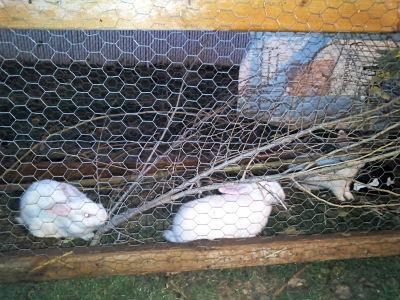Today I went out to check the new litters. I've got a couple mothers that like to sit in the nest box next to the babies this time of year. They stay warmer that way but I sometimes wonder if they aren't better off being left alone so they ball together and fluff the bedding around themselves to keep warm. One of the mothers was sitting on a kit. I picked it up and it was limp but still warm. I'm guessing she accidentally sat on it and choked the life out of it. I was about ready to throw it out but noticed it moved slightly, taking a feeble breath. I softly squeezed it's rib cage together rapidly three times and stopped. It just laid there in my hand. I squeezed again a few times, rapidly pushing air in and out of its lungs and hopefully stimulating the heart. Just an idea I stole from infant CPR training I took for foster care licensing. The kit took another breath and a second later another but no other movement. Thinking it unlikely to survive, I just laid it down next to it's siblings to keep warm.
Later when I went out to feed in the evening, I checked on the kit and it was doing great. Usually, when they are warm and limp, they are truly dead but I must of caught this one before it was too late.
When you find new kits that are cold and not breathing, it's a different story. Never assume they are dead until you've warmed them up. I usually put them inside my shirt to warm up. Many women will put them in their bra. I've also used a heating pad. You'd be surprised how many you thought were dead, come back to life.
Never put a cold kit who got separated, back in with their siblings, they often get smothered by the others or might get some of them chilled. Warm them up first.
If an entire litter got chilled due to moisture, or poor bedding. Clean out the nest box and put fresh bedding. Make sure there is a few inches of wood shavings or similar material on the bottom to act as insulation and to absorb any moisture. I've found that cross cut shredded paper also works well. I then put a bunch of grass hay around the outside and make a depression to place the litter. Put any of their mother's pulled fur back over them or use some dryer lint. It's a good idea to save extra fur and lint from your dryer in case you need it.
When you find dead kits:
If cold, they are not dead until they are warm and dead.
If warm, take a minute to squeeze their rib cage lightly together rapidly, then watch for movement.



